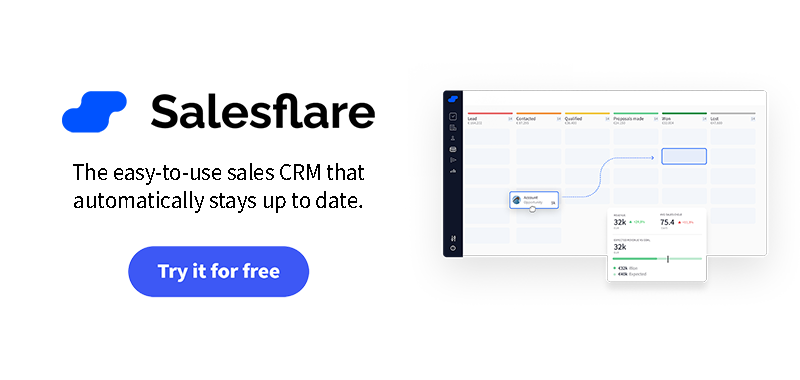CRMの導入:中小企業のためのステップ・バイ・ステップ・ガイド [2025]
スケジュール、ベストプラクティス、コストに関する考慮事項を含むプロセスを学ぶ
CRMの導入は、ビジネスにとって最良の決断のひとつとなり得る。ただし、正しい方法で行う場合に限ります。
私は、企業がCRMを適切に設定することで、営業プロセスを変革し、かつてない成長を遂げるのを見てきました。また、中途半端なCRMの導入も数多く見てきました。結局、誰も使わない埃をかぶったCRMになってしまったのです。
このガイドの目的は、このような落とし穴を回避することです。実際に機能するCRM導入への明確な道筋をつけたいのです。10年以上にわたって何千社ものCRMと営業プロセスを支援してきた私の実地経験に基づき、CRMを正しく導入するために知っておくべきことを説明します。
さあ、飛び込もう。👇
CRMの導入とは?
私たちが同じページにいるための定義だ:
CRMの導入とは、顧客関係管理(CRM)システムを組織で計画、設定、展開するプロセスです。言い換えれば、CRMをワークフローに適合させ、目標を達成し、売上を向上させることです。
単にソフトウェアをインストールするだけではありません。自社の営業プロセスに合わせてカスタマイズし、チームをトレーニングし、学びながら調整するのです。
中小企業(SMB)にとって、CRMは混沌とした営業管理とスケーラブルなシステムの違いを意味します。tracking your sales leads, management relationships, and empower your team to work together effectively.
CRMの導入が正しく行われれば、それは単なるテクノロジーではありません。ビジネスを成功に導く基盤を作ることなのです。
CRM導入成功のメリット
ステップ・バイ・ステップのプロセスに入る前に、CRM導入に力を入れる価値がある理由を考えてみましょう。
より良い顧客関係と売上成長
CRMを適切に導入すれば、完璧なフォローアップが可能になります。顧客とのやり取りをすべて把握できるため、信頼関係を構築しやすくなります。情報を探し回る必要がなくなれば、レスポンスも早くなり、フォローアップもタイムリーになります。
その結果、あなたの見込み客は、個別の注意を払ってもらっているように感じる。
チームのコラボレーションと透明性
営業チームが一丸となれば、良いことが起こります。CRMは、すべてのやり取りと顧客データベースを一元管理します。そのため、チームメンバーの誰かが病気になったり、会社を辞めたりしても、何も失われることはありません。
共同作業や洞察の共有が容易になり、各見込み客や顧客に何が起きているのかを常に把握することができる。
効率と収益の向上
効率化が鍵CRMは、営業担当者が嫌がる面倒な作業の多くを代行します。活動の記録、リマインダーの設定、同様の管理作業は自動化できます。
自動化により、チームは顧客との会話など、価値の高い活動に集中する時間を増やすことができます。例えば、Salesflareでは、CRMが自動的にコミュニケーションを記録し、次のアクションを提案します。つまり、管理業務が減り、実際の営業により多くの時間を割けるようになり、案件が滞ることも少なくなります。
プロセスの概要
詳細に入る前に、鳥瞰図をお見せしましょう。成功するCRM導入プロセスには、次のような重要なステップがあります:
- 目標を明確にする。
- 実施チームを編成する。
- 適切なCRMソフトウェアを選択する。
- カスタマージャーニーをマッピングする。
- データ移行を計画する。
- ニーズに合わせてCRMをカスタマイズ。
- 既存のツールとの統合
- チームを鍛える。
- 作業を開始し、最適化を続ける。
これらのステップのどれかをスキップすると、たいていの場合、その先で挫折を味わうことになる。
詳しく見ていこう。👇
CRM導入の9ステップ
ステップ1:CRMの目標を明確にする
これが最も重要なステップだ。まず「なぜ」から始めましょう。なぜCRMを導入するのか?何を達成したいのですか?
多くの中小企業にとって、これは "リードフォローアップの改善"、"顧客とのやり取りの記録"、"営業効率の向上 "といった単純なことかもしれない。
目標が明確であればあるほど、実施中に正しい決断を下すことが容易になる。
ステップ2:CRM導入チームの結成
導入の成功は、単独プロジェクトではない。複数の利害関係者の意見が必要なのだ。
最低でも、営業担当者、経営陣の代表者、そして理想的には技術的な要件を理解している者が必要だ。営業チームからの賛同を得ることは特に重要です。結局のところ、システムを毎日使うのは彼らなのですから。
ステップ3:適切なCRMソフトウェアを選択する
すべてのCRMが同じように作られているわけではありません。あなたの目標に合致し、あなたのチームが実際に使用するCRMが必要です。
CRMを選択するためのいくつかのポイントを紹介します:
- 自分の目標との整合性は?ステップ1をご覧ください。
- 私の業界では有効ですか?例えば、B2BとB2Cのセールスは全く異なります。
- 私が使っているものとうまく統合できるか:電子メールの受信箱のタイプ、他のコミュニケーション・チャンネルなど。
- もし、あなたが時々外出することがあるのなら、素晴らしいモバイルアプリを持っているだろうか?
多くの中小企業にとって、使いやすさ、自動化、およびEメールやLinkedInのようなツールとの統合があります。例えばSalesflareは、CRM for B2B営業チームは、リードを管理するための簡単で自動化されたソリューションを必要としています。
ステップ4:カスタマージャーニーの地図
優れたCRMの導入は、カスタマージャーニーを理解することから始まります。顧客はどのように貴社を発見するのか?購入までにどのようなステップを踏むのか?
CRMが最初の認知からリピート購入まで、すべての段階をサポートできるように、これらのタッチポイントをマッピングしましょう。これにより、システムを最大限に活用するために必要なCRMの機能を判断しやすくなります。また、パイプラインのカスタマイズも簡単になります。

ステップ5:データ移行計画
データ移行は最も厄介な作業の一つです。どのデータをスプレッドシートや古いシステムから新しいCRMに移行するかを決める必要があります。
選択的であれ。何でもかんでも移行すればいいというわけではありません。データを整理し、重複を取り除き、残ったデータが正確で最新であることを確認しましょう。データの質が低いと、CRMエクスペリエンスも低下します。
ステップ6:営業プロセスに合わせてCRMをカスタマイズする
CRMは、既存の営業プロセスを反映させるのが最も効果的です。フィールド、ワークフロー、パイプラインをカスタマイズして、チームが実際にどのように仕事をしているかに合わせましょう。
これにより、CRMは障害ではなく味方になります。例えば、Salesflareでは、セールス パイプラインに、シンプルな5段階のファネルであれ、より詳細なアプローチであれ、独自のプロセスを反映したカスタム ステージを作成できます。
ステップ7:CRMを他のツールと統合する
CRMは独立したツールであるべきではありません。最大の価値を得るためには、チームが使用している他のツールと統合しましょう。メールの受信トレイ(GmailやOutlookなど)、カレンダー、LinkedInを接続しましょう。
これらの統合により、手入力が減り、一箇所ですべてを確認することができます。Salesflareを使えば、統合は簡単です。アカウントを接続するだけで、CRMが電子メールやカレンダーのイベントを同期してくれます。さらに、LinkedInメール検索を備えたChrome拡張機能もあります。

ステップ8:チームのトレーニング
CRMがどんなに使いやすいものであっても、トレーニングは譲れません。システムの使い方に慣れてもらい、なぜそれが有益なのかを理解してもらう必要があります。
まずは基本的なことから始めましょう。アクティビティーの記録、コンタクトの追加、パイプラインを通じた案件の進め方などです。ビデオチュートリアルや、チームメンバーが質問に答える「オフィスアワー」など、継続的なサポートやリソースでフォローアップする。
ステップ9:作業を開始し、最適化を続ける
研修の1カ月後に2回目のミーティングを計画し、新たな質問を受けたり、状況についてフィードバックを得たりする。
そのフィードバックをもとに、最終的な調整を行う。本番稼動後は、どのように機能しているかをモニターし続け、チームが慣れてきたら調整する。CRMの導入は継続的なプロセスです。繰り返せば繰り返すほど、より多くのものを得ることができます。
CRM導入計画とタイムラインの作成
マイルストーンの定義
優れた実施計画には、マイルストーンが含まれている。例えば
- 第1週:目標を定め、実行チームを編成する。
- 第2-3週:CRMを選択し、データクリーニングを開始します。
- 第3-5週:CRMをカスタマイズし、お客様のツールと統合します。
- 第6週:チームのトレーニング
- 第10週:チームとのフォローアップミーティング。
物事を細分化することで、全員がいつ何をすべきかを一致させることができる。
典型的なCRM導入スケジュール
ほとんどの中小企業では、CRMの導入は最初から最後まで6週間程度で完了します。プロセスを急ぐとミスを招き、時間がかかりすぎると勢いを失うことになります。
スケジュールはあなたの複雑さによって異なるが、重要なのは一貫した進歩を維持することである。
CRM導入戦略:4つのベストプラクティス
初日からチームを巻き込む
私が目にするCRM導入の最大の失敗は、経営陣がチームからの意見をあまり聞かずにCRMを選択し、導入した場合である。
それを毎日使うのは営業担当者だ。彼らは早くから参加する必要があり、そうすることで投資を感じ、価値を見出すことができるのです。
物事をシンプルに
小さく始める。フィールドやステージ、複雑さを増やせば増やすほど、チームが一貫して使う可能性は低くなる。
CRMはデータがあってこそ成り立つものです。データ入力はできるだけ簡素化し、不必要な要件でチームに負担をかけないようにしましょう。
すべてを記録する
ドキュメンテーションはCRM導入の成功の鍵です。適切なドキュメンテーションがなければ、チームのメンバーはシステムの特定の部分がどのように機能するのか、あるいはどのようなプロセスに従えばよいのかを簡単に忘れてしまいます。
共有ドキュメント(Google DocsやNotionでも可)を作成し、そこで定義する:
- 営業プロセス
- CRMの各フィールドの意味。
- さまざまな顧客のシナリオに対処する方法
- データ入力とフォローアップのベストプラクティス
この文書に全員がアクセスできるようにすることで、一貫性が保たれます。また、新メンバーを効率的に採用するのにも役立ちます。プロセスが進化するにつれて、常に更新していきましょう。
できるところから自動化する
自動化すればするほど、チームはCRMを継続しやすくなります。例えば、Salesflareは、電子メールと会議を自動的に記録し、CRMを最新の状態に保つための多くの手作業を省きます。

自動化は管理業務を減らし、営業により多くの時間を割くことを意味する。
CRM導入のロードマップと共通の課題
進むべき道を可視化する
ロードマップは、全員の足並みをそろえるのに役立つ。各段階、責任者、成功のイメージを文書化する。
可能であれば視覚的なものを使う。マイルストーンを記したシンプルなタイムラインは、全員が軌道に乗るための強力なツールとなる。
主な課題と解決策
ここでは、よくあるCRMの課題とその克服方法を紹介します:
- 変化への抵抗:人は新しい道具に抵抗することが多い。このような場合は、最初から彼らを CRMの選択 そして、CRMがいかに彼らの仕事を容易にするかを示す。
- データ移行の問題:質の悪いデータは、CRMを開始する前に台無しにしてしまいます。前もって時間をかけてデータをきれいにし、必要なものだけを移行しましょう。
- セットアップの複雑化:すぐに多くのカスタムフィールドやワークフローを追加するのは、よくある間違いです。必要なものから始めて、そこから積み上げていきましょう。
CRM導入コスト
費用の内訳
CRMの導入は、ソフトウェア・ライセンスだけではありません。コストには以下が含まれます:
- ソフトウェア費用:CRMの月額または年額利用料。
- トレーニング費用:チームを快適にするために費やされる時間とリソース。
- カスタマイズと統合コスト:CRMのカスタマイズや統合に外部の助けが必要な場合。
コストの落とし穴を避ける
初期費用と継続的な費用の両方を計画することで、驚きを避けることができる。
トレーニングに必要な時間を軽視してはいけません。チームのトレーニングが十分でなければ、CRMの価値は急落します。
また、先のことを考えずに無料プランやスタータープランでCRMを始めないようにしましょう。アップグレードすると非常に高くつく可能性があります(HubSpotとSalesforce)。
CRM導入の成功事例
ResultConsulting がSalesflareを採用する前、彼らの顧客関係管理は「大混乱」でした。エクセルのシートと紙のメモを組み合わせて使っており、適切に整理されていなかったのです。そのため、業務を専門化する必要がありました。
当時、ResultConsultingはマッテオとジャコモ、2人の創業コンサルタントだけだった。

成功への最大の障害は、選択したCRMを実際に使用することであることを彼らは知っていた。多くのCRM導入が失敗するのは、単にチームが使いたがらないからだ:CRMは一般的に、更新に手間がかかりすぎ、営業チームがリードをフォローアップする純粋な助けにならないことが多い。
そこで彼らは、インテリジェントなコンサルタントのために設計されたCRM、代理店、新興企業やその他のB2B企業向けに設計されたCRMで、大部分は最新の状態を維持し、見込み客へのフォローアップを積極的にユーザーに思い出させる。彼らはそれを試してみることにした。
Salesflareを使用することで、競合システムのような煩雑さがないことがわかりました。Salesflareを導入することで、顧客との関係をよりよく整理できるようになり、販売データをより一貫して把握できるようになりました。
具体的には、CRMとしてSalesflareを導入したことで、2つの大きな変化があった:
- Salesflareを使う前は、フォローアップを忘れたり、期待通りにフォローアップしなかったりしただけで、既存の販売機会のうち約60%を失っていた。Salesflareでは、一貫してフォローアップを行うことで、収益を2倍以上(2.5倍)にすることができた。
- また、Salesflareは、実データに基づく販売プロセスの改善も可能にした。これにより、同社はプロセスのボトルネックを特定することができた。そのボトルネックの1つを解決するだけで、同社は売上を再び2倍以上(2.6倍)にすることができた。
ResultConsultingは、Salesflareを通じて得た洞察に基づき、リードのフォローアップを改善し、販売プロセスを改善しただけで、2年足らずで収益を6.5倍以上に伸ばした。
それについては、コンサルタントはどのようにCRMを使うのかの記事をお読みください。
導入後成功の測定と継続的改善
KPIのトラッキング
CRMを稼動させましたが、うまくいっていることをどうやって確認しますか?重要業績評価指標(KPI)が有効です。
以下のような指標の追跡を検討する:
- コンバージョン率:リードはパイプラインをどの程度進んでいますか?
- 販売サイクルの長さ:商談成立のスピードは上がっているか?
- ユーザーの採用率:あなたのチームはCRMを実際に使っていますか?
反復と改善
本番稼動後は、最適化を続けることで本当の魔法が起こる。CRMは、営業プロセスのどこにボトルネックがあるかを示してくれるので、それに応じて変更を加えることができます。導入は始まりに過ぎません。ゴールは磨き続けることです。
CRMは、営業活動のバックボーンとなります。プロセスを合理化し、顧客との関係を改善し、ビジネスを成長させるのに役立ちます。重要なのは、思慮深く行うことです。
セールスを次のレベルに引き上げる準備ができたのなら、今が始める時です。CRMの目標を定め、チームを巻き込み、全員のために機能するシステムを構築しましょう。
もちろん、ご指導が必要な場合や、Salesflareがどのように役立つか確認したい場合は、ご連絡ください。私たちは、すべてのステップであなたをサポートします。
よくあるご質問
CRMの導入を成功させるには?
CRM導入の成功は、いくつかのベストプラクティスにかかっている。まず、初日から営業チームを巻き込み、彼らの賛同を得ること。初期設定はシンプルにし、不必要な複雑さよりもコアなニーズに焦点を当てます。営業プロセスとそれをCRMがどのようにサポートするかを文書化し、手作業を減らすためにメールやミーティングの記録など、可能な限り自動化しましょう。Salesflareのような自動化されたCRMを使用することで、このような作業はより簡単になります。
CRM導入における5つの重要なステップとは?
完全な実施には多くのステップがあるが、最も重要なのは次の5つである:
- 目標を明確にする: リードフォローアップの改善や営業効率の向上など、CRMで達成したいことを明確に設定しましょう。
- 適切なソフトウェアを選択する: 自社の目標に合致し、業界に適合し、チームが使いやすいCRMを選びましょう。
- データ移行を計画する: 旧システムから移行するデータを決定し、クリーンアップし、重複を削除してから移行する。
- CRMをカスタマイズする: CRMのパイプライン、フィールド、ワークフローを特定の営業プロセスに適合させます。
- チームを鍛える: システムの利点を最大化し、採用を確実にするために、全員がシステムの効果的な使用方法を知っているようにする。
CRM導入の課題とは?
CRM導入時の最も一般的な課題は、チームからの変化への抵抗、旧システムからのデータのクリーンな移行の問題、カスタムフィールドや複雑なワークフローの多用による初期設定の複雑化です。これらの課題は、早期にチームを巻き込み、慎重にデータ移行を計画し、シンプルで集中的なセットアップから始めることで克服することができます。
CRMの導入時期
スプレッドシートやメモのような現在の方法が "大混乱 "に陥ったら、CRMを導入する時です。リードを見失い、フォローアップを忘れ、チームとしてのコラボレーションに苦労しているのであれば、そのシステムはもう古いのです。SalesflareのようなCRMは、業務を専門化し、ビジネスを効果的に拡大するために必要な構造と組織を提供します。
CRM導入はなぜ失敗するのか?
CRMの導入が失敗する最大の理由は、ユーザーの導入率が低いことです。チームがCRMを使わなければ意味がありません。これは通常、選択されたCRMが複雑すぎ、手作業が多く、チームの意見を聞かずに選択されたために起こります。Salesflareのような使いやすく、自動化されたCRMを選択し、チームを決定に参加させることで、成功の可能性は劇的に高まります。

この記事を気に入っていただけたなら幸いです。もし気に入っていただけたなら、この記事を広めてください!
👉あなたは、で@salesflareをフォローすることができます Twitter, Facebook LinkedIn..
最終更新日
- 7 Best CRMs for Mac in 2025 - 9月 19, 2025
- 7 Best HubSpot CRM Alternatives in 2025 - 9月 17, 2025
- 7 Best Pipedrive Alternatives in 2025 - 9月 16, 2025